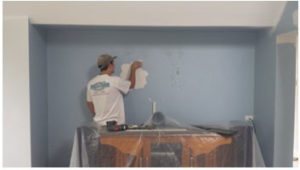How to Repair Plaster
 Cracked or broken plaster is a common problem in homes, both new and old. Whether it’s caused by the house settling into its foundations or accidental bumps from furniture or doors, plaster repair is something many Brisbane homeowners will need to tackle. For minor cosmetic damage, you can often handle the repairs yourself, but for more serious issues, like cracks in the ceiling, it’s a good idea to call a professional.
Cracked or broken plaster is a common problem in homes, both new and old. Whether it’s caused by the house settling into its foundations or accidental bumps from furniture or doors, plaster repair is something many Brisbane homeowners will need to tackle. For minor cosmetic damage, you can often handle the repairs yourself, but for more serious issues, like cracks in the ceiling, it’s a good idea to call a professional.
Repairing Hairline Cracks in Plaster Walls
Hairline cracks are usually cosmetic, and we suggest repairing them as close to when you plan to paint as possible.
The main issue with repairing hairline cracks is they are too thin to provide a solid base for the plaster. Try removing small amounts of plaster at regular intervals along the crack. Then, clear out any dust or dirt; if you use water to do this, allow the crack to dry completely.
Using plaster and a spackling knife, fill in the crack. Be sure to overlap the new plaster and existing plaster. Allow the plaster to dry for 24 hours. Sometimes the dried plaster will recede back into the crack. If this happens, just patch again with plaster.
Once dry, you can sand, prime and paint.
Repairing Holes in Plaster Walls
Repairing holes in plaster walls requires a few more steps than repairing hairline cracks.
First, you’ll need to clean the area of dust and dirt, and remove any loose plaster. Then, dampen the edge of the hole, and fill with plaster. Ensure you do not fill the hole enough to make it level with the existing plaster. You need to leave room for the joint compound. Score the wet plaster with your spackling tool in a hash pattern, and leave to dry for 24 hours.
After the plaster has dried, apply the joint compound. Cover the hole completely, allowing a small overlap over the existing plaster. Apply a second coat if necessary.
Once dry, sand, prime and paint.
Plaster Repairs Not Suitable for DIY
Even if you’re confident with the above two repair methods, there are some plaster repairs that are not suitable for DIY.
One is repair to ceilings. This is difficult not only because the ceiling is difficult to reach, but also because of the possible consequences of a less than perfect repair.
A second is repair to skirting boards, cornices, and other decorative features. It can be tricky to create a seamless repair, and any obvious patches will take away from the look of your room. Here’s a repair we made on a cornice that was damaged.
The first image shows the extent of the damage. The second shows the cornice after it had been patched. The third shows the cornice completely repaired and repainted.
Lastly, it’s probably best to call in the professionals for holes in your wall that are any larger than your hand.
Professional Solutions for Plaster Repair in Brisbane
If you don’t feel confident repairing damaged plaster yourself, no worries. We can repair, sand, prime, and paint cracks and holes in plaster walls. You’d never be able to tell they were there! Give us a call on 07 3829 5735, or fill out the form on this page.
With years of experience, a proven track record, and a commitment to customer service, Kraudelt Painting in Brisbane is the house painting company you can rely on.


I’m glad you say that some repairs are not good for DIY. My husband wants to repair our ceiling my himself, but it makes me nervous to think of him doing it basically upside down. We have several cracks throughout our ceiling that need to be repaired. I think I’ll call a professional to do it today. Thanks for sharing!
Good idea Annie – it’s important to be safe. If you’d like us to help, please don’t hesitate to contact us.